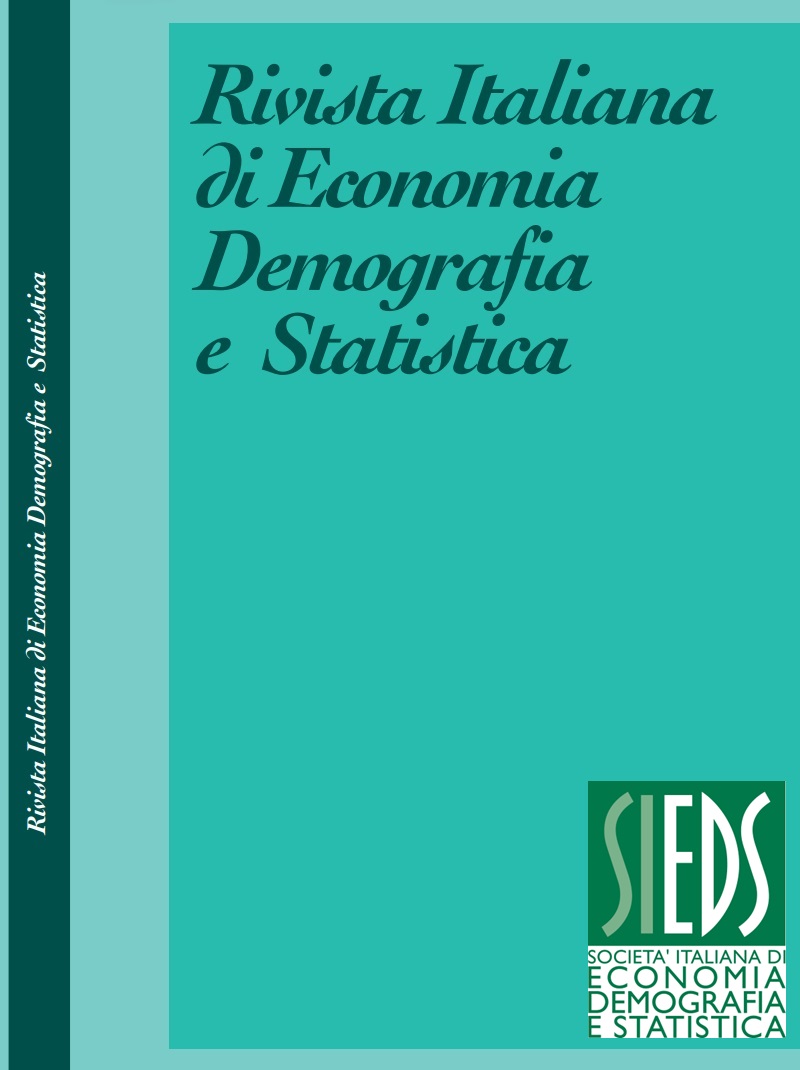Integrating administrative data with Istat surveys for municipal homelessness risk assessment
DOI:
https://doi.org/10.71014/sieds.v79i3.358Keywords:
Homeless, Integrated sources for official statistics, Permanent Census of Population and Housing, Data collection improvement, Municipal classificationAbstract
This study investigates the insights and analytical potential of integrating ISTAT data sources concerning the homeless population. The main goal is to derive new municipal classifications associated with different levels of expected homelessness rates, crucial for designing tailored sample surveys. Comprehensive direct enumeration of the homeless population is cost-intensive and often impractical, while accurate territorial indicators could guide surveys only in specific areas.
The surveys sources considered are the National Survey on Homelessness in Italy (2011 and 2014), annual surveys on residential socio-assistance facilities, the permanent census of non-profit institutions, and annual surveys on administrative population registers. Furthermore, the Integrated Data Base of Usual Residents (AIDA) has been integrated, since the AIDA individual occurrences, known as Signs of Life (SoL), combine information from many administrative sources to enhance the analysis of specific population profiles.
This paper begins with an introduction to the challenges of data collection on homelessness and the importance of integrating various data sources. It then reviews existing ISTAT surveys and administrative databases, detailing their possible role in estimating the homeless presence at municipal level. The methodology section describes the municipal dataset built to analyse integrated sources and the computation of 'risk' indicators that are supposed to be associated with homeless presence.
Results highlight opportunities for improvement of data quality and implications for data collection and estimation. Future research goals include updated ad hoc surveys and the design of an information system for continuous monitoring of homelessness in Italy.
References
AMORE K., BACKER M., HOWDEN-CHAPMAN P. 2011. The ETHOS Definition and Classification of Homelessness: An Analysis, European Journal of Homelessness, Vol. 5, No. 2, pp. 19-37.
BERNARDINI A., CHIEPPA A., TAMBURRANO T. 2024. Discovering individual profiles from administrative signs of life useful for the estimation of Census results, RIEDS - Rivista Italiana di Economia, Demografia e Statistica, Vol. 78, No. 1, pp. 15-24.
BUSCH-GEERTSEMA V. et al. 2010. Homelessness and homeless policies in Europe: Lessons from research. In Conference on Homelessness, Vol. 9.
BUSCH-GEERTSEMA V., et al. 2014. Extent and Profile of Homelessness in European Member States: A Statistical Update. FEANTSA, Brussels.
DELLA QUEVA S., LEPORANICO V., NICOSIA M., STOPPIELLO S. 2023. The nonprofit sector in Italian Inner Areas, Rivista di Statistica Ufficiale, Vol. 77-4.
EDGAR B., HARRISON M., et al. 2007. Measurement of Homelessness at European Union Level. Brussels: European Commission.
GOSME L. 2014. Key steps towards a European Union homelessness policy, Journal of European Social Policy, Vol. 24, No. 3, pp. 289-299. DOI: https://doi.org/10.1177/0958928714525816
INGLESE F., MASI A. 2021. Una metodologia per la stima della homelessness attraverso le Unità di strada: il caso della città di Torino. ISTAT WORKING PAPERS N. 5/2019, Istat-Istituto Nazionale di Statistica, Roma.
ISTAT. 2014. La ricerca nazionale sulla condizione delle persone senza dimora in Italia. Roma: ISTAT.
ISTAT. 2022. Piano Generale del Censimento Permanente della Popolazione e delle Abitazioni 2022-2031.Roma: ISTAT.
ISTAT. 2023. Le strutture residenziali socio-assistenziali e socio-sanitarie, 1° gennaio 2022. Roma: ISTAT.
LETERME Y., DEVELTERE P. 2023. The European Platform on Combating Homelessness (EPOCH): From Policy to Practice and from Practice to Policy, European Journal of Homelessness, Vol. 17, No. 2.
O'SULLIVAN E., PLEACE N., et al. 2020. Distorting Tendencies in Understanding Homelessness in Europe, European Journal of Homelessness, Vol. 14, No. 3, pp. 109-135.
ZINDATO D., TRUSZCZYNSKI M. 2023. Hard-to-reach population groups in administrative sources: Main challenges and future work, Statistical Journal of the IAOS, Vol. 39, pp. 849-863. DOI: https://doi.org/10.3233/SJI-230074
Downloads
Published
Issue
Section
License
Copyright (c) 2025 Angela Chieppa, Marija Mamolo

This work is licensed under a Creative Commons Attribution 4.0 International License.



